Upstairs/downstairs; Examining staff quarters
For comparison’s sake I have to start with the grand staircase. That’s because I think it’s the most shocking example of inequality/aristocratic thinking. As incredible as it may seem to us today, not so long ago there was a world in which house-staff was so less than the people who employed them, having them circulating through the grand parts of the house was simply unthinkable.
Well hidden behind panelled doors with locks only on the family side is the other staircase.
Going up the service stairs, you get to the staff living room. It’s not big. The living, toilette area and five bedrooms all come to a total of 150m2 (1614 sq. feet.) Keep in mind this space was shared by 10 people.
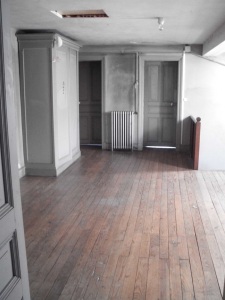 I don’t know what sort of furniture they had to sit on, but I’m guessing just wooden chairs and maybe a table. The toilette area is in the corner, to the right of where I’m standing when I took the picture. It’s open to the room! I can see hooks which means it was curtained off, at least.
I don’t know what sort of furniture they had to sit on, but I’m guessing just wooden chairs and maybe a table. The toilette area is in the corner, to the right of where I’m standing when I took the picture. It’s open to the room! I can see hooks which means it was curtained off, at least.
Happy new year is written in chalk on the cupboard above. Probably a play on words as bonne also means maid + the name Anne. There were also some paper decorations in the form of a string of cutout flowers. Kind of touching. Notice there’s no loo, only a bidet. To go the staff loo, they have to go all the way down the stairs and then cross the basement. The bedrooms aren’t too bad.
All of the bedrooms have a storage area in the form of a crawl space. Another shocking thing is that although there are two little radiators in the living area, there are none in any of the bedrooms. Why do poor people need heating? Freezing temperatures are character building! Now back down we go to the basement. The service stairs land you smack in the centre of a dark workshop area. After your eyes adjust you see daylight coming from your left. Going through the corridor, you get to the one and only staff loo/shower. The floor is just plain concrete. This little room must have been perpetually wet all over.
Also on this level is the staff kitchen. It’s not so bad. It’s got a window and its own door with steps that lead up into the garden. This served a variety of purposes. The gardener/chauffeur etc. could come in and out of the house without walking through the family areas. They could also get food and supplies in and out without disturbing the family.
There are some other interesting things… All the doors in the staff areas have finger plates to stop their dirty hands damaging the paintwork (didn’t quite work.)
And they’re not supposed to leave open any doors that have access to the family parts of the house. This is made abundantly clear by not entirely friendly little signs on every single door that can access the family sections. The signs also happen to grace their kitchen and loo.
I wouldn’t have liked to have been born on the wrong side of the doors. I get a strong sense of deep condescension. Interestingly enough, I didn’t grasp such things as a child having been a boy who was born on the right side of the doors.
It also feels very permanent, devoid of hope. In those days once someone got a job working in this sort of house, that was it. They’d spend the rest of their lives quickly closing the doors behind them as to not upset anyone, scurrying from the gates to the service kitchen as to not be seen. Probably looking out of their windows and into the grand surrounding houses wondering what it’s like not to have to share a loo with nine other people.

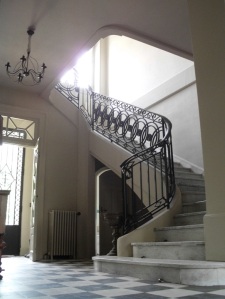
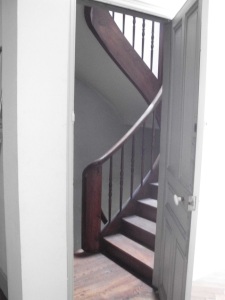
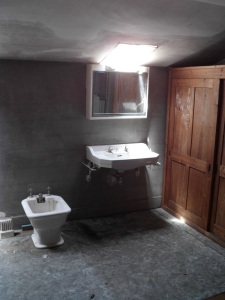
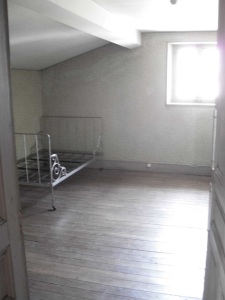
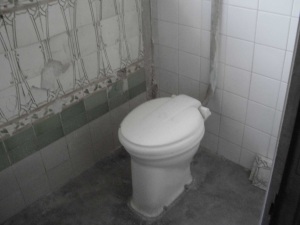

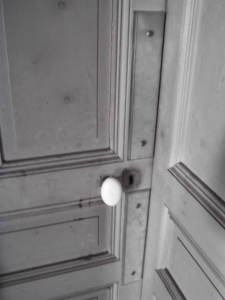
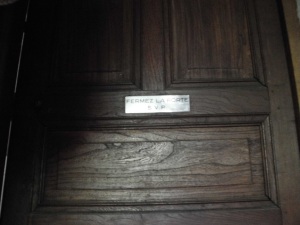
Even the staff staircase is posh! Looks slightly Shakerish, or maybe that’s the effect of the grey paint. (Which I like).
The sitting room is nice, but maybe not so nice for Ten! people. Nightmare. I’d be hiding in my bedroom.
I like the arty tiles in th toilet but they look damaged 😦
This house is huge! Cleaning comes to mind again.
My parents’ house had finger plates. They were quite pretty, sort of china things. Must have been to stop my grubby fingers.
LikeLiked by 2 people
It’s not small 😀 Most of the other houses of this type in town are now either public buildings or have been transformed into blocks of flats with anything from 6 to 10 apartments. If you’re using Spanish metros construidos measurements it’s around 750m2. If you’re using French interior room measurements it’s 650.
One of the reasons I thought it would be interesting to preserve this place is it was still used as a private home- it’s also why I’m fighting Mike on changing anything that takes away from how the house functioned when it was built. Scullery stays, service stairs stay. Separate male and female loos stay (The seats on the male loos are counterweighted so they’re always up!)
LikeLiked by 2 people
I’m with you on the fight 😉 But this is the woman who never changes anything unless absolutely necessary. Eg, getting rid of a cracked ant-ridden sink is necessary. Taking off dirty broken tiles is necessary.
Ripping out burgundy plastic baths (or any plastic coloured baths) is necessary.
Ripping up vile cheap synthetic carpets is necessary.
Because none of those added to the properties. They were tasteless, dysfunctional and not in keeping anyway.
LikeLiked by 1 person
These photos are great but rather thought provoking. You talk about a sense of hopelessness and yet, the staff of a well-to-do house would be so much better off than say someone working as a shop assistant, or tradesman etc. Even class would have been relative. 😦
LikeLike
Definitely, but it’s still not great to be stuck. There was no real chance of making a better life. They worked hard from adolescence up to an age when they physically couldn’t work anymore. And then what? Not a retirement community in Florida. Probably a little cottage on the outskirts of town with no heating but an open fire. That’s a tough life.
LikeLike
Actually in a small place an open fire is surprisingly warm. Also smoky and sooty, but that’s another story. Spent first three years of my marriage in the parents’ granny flat. It was tiny and the fire kept it quite cosy. And of course I’d never want to live like that again. 😀
LikeLiked by 1 person
Roughseas is right, its huge. Hide and Seek must have been fun for any kids growing up there 🙂
LikeLike
and exhausting! It would take ages to find someone here. It’s hard enough when someone isn’t hiding. At the moment when we’re trying to find each other we go to the stairs and scream, that’s the best chance we have of the other one hearing 🙂
LikeLiked by 1 person
Ah, know that method well. Growing up in a 3-storey house i understand big lungs help 🙂
LikeLiked by 1 person
Fabulous place; don’t you feel a little like two peas in a pod at times though? Perhaps you do lots of socialising and have guests stay to fill up the space, or plan to. Space and light are so important, yet for me – and this is just a personal thing – there is an optimum beyond which I might begin to feel as though they were working against my preferred emotional states. I live alone in a modest farmhouse which has about the right balance of space and light for me, although I’m sure it’s only a fraction of the size of your and Mike’s palatial abode, and certainly nowhere near as grand.
LikeLike
I love moody, darkish rooms. Fortunately I manage to get that by playing with the shutters and curtains.
The great thing about it is although there’s space, it’s all divided into domestic sized rooms. The grey formal salon which is the largest is only 35m2. The green salon with the dark wallpaper is only 30m2. The other good thing is the rooms open onto each other with big double doors, which of course makes them feel much bigger. When we first arrived and it was cold we spent most our time in the green salon with the doors closed, now it’s hot I’ve opened all the doors.
LikeLiked by 1 person
Sounds wonderfully practical; perhaps I could live in a palace after all. Oh, wait a minute . . . [English property prices]
LikeLike
Have you thought of this sort of thing?
http://www.messynessychic.com/2015/07/01/heres-a-catalog-of-secret-paris-filming-locations-used-by-french-industry-scouts/
LikeLike
We used to do that with our house in Spain. Maybe in the future once the house is done 🙂 At the moment we have to really just focus on getting it more or less in decent condition. Our first summer guests arrive in 25 days!
LikeLiked by 1 person
Wouldn’t it be lovely if filming, there, led to new furniture and other bits and pieces, once the cast and crew no longer needed them?
LikeLike
Meanwhile, here in Bay Ridge, Brooklyn, NY…in the 1980’s, my Italian-American mother hired a cleaning lady, a woman to come to the house once a week and clean. Rather than let the exalted cleaning lady see that the house was in fact a mess (mine & my sisters’ toys all over the place, my father’s shirt on the floor, etc) she (my mother) would clean the entire house before the cleaning lady came. The cleaning lady would then show up and find NOTHING TO CLEAN, so she’d sit and watch TV the whole day. My mother eventually asked her not to come anymore because she wasn’t doing anything. We say the people in the upstairs/downstairs houses were classist and elitist but they knew who they were. The problem with people today (in my mind) is they feel guilty about living on the “right” side of the doors.
LikeLike
So recognisable, even to the style of the backstairs, but the bedrooms in our place were smaller, though similar in not being provided with heating. No notices though…
I was lucky enough to meet the woman who had been the cook in the last years of the house being in full swing….she and her husband, the gardener, lived out as the then owner was a widow and would not have men sleeping on the premises, but the maids still lived in and were confined to their end of the house when not cleaning, etc., unless summoned by the bells which still existed in the kitchen when we bought the place. The only time they touched the front door was to open it for visitors…otherwise they and the gardener used the back door to the kitchen.
She was thrilled to be taken into the main salon and to take her coffee and cake there – something, she said, that she could never have imagined in the days of her working life.
I disagree with acflory…domestic service was the pits socially.
LikeLiked by 1 person
How funny, we met the maid who used to work here as well. They paid her to show us how to work everything.
When we invited her to sit down for a cup of tea, she asked where she could get a normal chair because she “must not sit on the sofas…”
It must be the pits to be made to believe one isn’t good enough/clean enough/dignified enough to sit on upholstered furniture.
LikeLiked by 2 people
It gives one a great distaste for those who enforce that belief….
LikeLiked by 2 people
I’ve always enjoyed the “Upstairs/Downstairs” fictions, from “Jeeves & Wooster” to “Remains of the Day” perhaps because I’ve never had servants nor been one.
I remember an interview with Jean Marsh from the 1970s. She produced “Upstairs / Downstairs” besides playing Rose, the head housemaid. She said her mother was upset that she was playing a maid instead of a Lady: she didn’t understand that Jean was the STAR. I also remember a moment from the early part of the series: Eaton Place was so small it had only one staircase, so the servants were instructed to scurry up and down quickly when the family wasn’t around. If they were caught on the staircase, they were to stand to the wall side and turn their backs, so the family could pretend they weren’t there.
But do remember, that lower class families were eager to get their children into service, because it was better life than living in slums and working in factories. O tempora, o mores!
LikeLike
They were eager to get their kids into anything which took the burden of feeding them off their hands.
LikeLike
There might also have been a sense of security in such a job: roof over the head, food in the belly. Barely much, but so many had less. On the other hand, it seemed to require a life of staying single to serve “the family” rather than having a family of one’s own.
LikeLike
One of the things you’re not commenting on is just how little time the staff had to spend in their bedrooms. Keeping a family fed when nothing was instant, maintaining a house that size clean and in good repair (as well as the stables/grounds/vehicles), always being available to the family, they really didn’t have much time to spend in the quarters. And those kitchen maids who spent all day cooking, and the scullery maids who spent all day washing dishes, probably didn’t get very cold. Also, you’re assuming that they all slept in separate beds, which isn’t very likely. I’m not saying the servants were all lovers, just that you can keep pretty warm when you’re two or three to a bed, and it saves on the furniture.
LikeLiked by 1 person